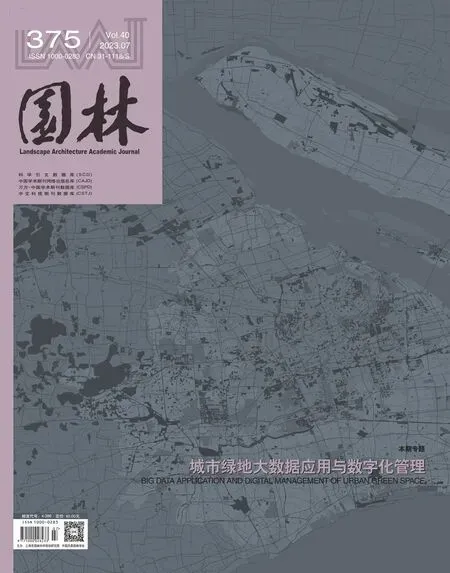城市绿地管理的数字化转型
20世纪末期,“数字地球”概念的提出标志着数字技术赋能人类社会发展的思想在国内落地。2023年4月,国家网信办发布的《数字中国发展报告(2022年)》显示,数字技术在生产、生活、生态治理等多领域践行绿色低碳发展理念,已持续赋能生态文明建设。数字技术所带来的极大便利、数据挖掘所带来的无限价值,日益成为各行各业创新发展的内生动力。
数据采集技术的迅猛发展使得动态共享数据库的建立成为可能。在风景园林领域,以公众需求为导向、技术革新为支撑的数字孪生模型层出不穷,并广泛应用于参数化设计、数字化建造以及工程项目设计、施工、运营全过程。然而,数字技术蓬勃发展,海量数据带来便捷高效的同时,城市绿地数字化管理中的难题也逐渐显现,主要体现在以下方面:一是需直面海量数据的清洗与筛选难题,避免影响数据挖掘建模的执行效率;二是建立在指标体系之上的模型构建往往存在人为因素,如何使得模型建构更为客观是关键也是难点;三是公众对作为公共产品的城市绿地的需求是不断变化的,海量数据表征过去和现在,也需要预测展示未来,才能更好地服务于管理决策。
本期专题“城市绿地大数据应用与数字化管理”,基于实证直面风景园林领域数字化管理过程中的数据清洗、指标构建、技术革新等热点议题,具有重要的实践探索价值。构建了包含多源感知、综合管理、信息互联、分析决策4个维度的数字化管治评估体系,以厘清公园数字化场景的系统结构、建设重点和未来发展趋势;将POI数据和遥感数据创新应用于城市开放共享附属绿地的筛选,构建了开放共享适宜性的评价指标体系,助力人口高密城市绿色公共空间的挖掘;剖析公园生境和人类活动之间的协同关系,归纳了以“人鸟和谐共生”为导向的亲自然游憩环境优化策略;基于公园游憩活动的时间规律融合分析,提炼了“日夜活跃度”定量分析指标,以提高城市公园绿地的夜间管理水平;针对数据、模型和实体之间无法高效精准匹配的信息化模型技术系统性问题,构建了一整套公园绿地数字孪生建设技术体系。
城市绿地为人与自然和谐共生、物质与精神有机交融提供场域。数字化时代的城市绿地依托大数据与数字孪生发展,将更加注重城市生物多样性的保护、市民个性化游憩需求的满足、社会综合服务效益的提升,尤其是其管理工作的智能化到智慧化转型。未来的城市绿地建设将面对更多变的环境元素、更多源的服务对象和更前瞻性的决策需求,城市绿地管理的数字化转型,仍需要风景园林与数字化技术的持续交叉融合,由此,为智慧城市建设贡献力量。
主编
2023年6月12日
Digital Transformation of Urban Green Space Management
At the end of the 20th century, the concept of “Digital Earth” was introduced,marking the arrival of the idea of digital technology enabling the development of human society in China.In April 2023, theDigitalChinaDevelopmentReport(2022)released by Cyberspace Administration of China showed that digital technology has continued to empower the construction of ecological civilization by practicing the concept of green and low-carbon development in multiple fields, including production, life and ecological governance.The great convenience brought by digital technology and the infinite value brought by data mining have increasingly become the endogenous driving force of innovation and development in all walks of life.
The rapid development of data acquisition technology has made it possible to create dynamic shared databases.In the field of landscape architecture, digital twin models oriented to public demand and supported by technological innovation have emerged in an endless stream, and are widely used in parametric design, digital construction and the whole process of engineering project design, construction and operation.However, digital technology is booming and massive data brings convenience and efficiency, while the difficulties in digital management of urban green space are also emerging, mainly in the following aspects: First, the need to face the cleaning and screening of massive data to avoid affecting the efficiency of data mining and modeling implementation; Second, the construction of models built on the index system often has human factors, how to make the model construction more objective is the key and difficult; Third, the public’s demand for urban green space as a public product is constantly changing.Massive data characterizes the past and present, and also needs to predict and showcase the future, so as to better serve the management decisions.
The topic of this issue, “Big Data Application and Digital Management of Urban Green Space”, is based on empirical evidence to face the hot topics of data cleaning,index construction and technical innovation in the process of digital management, and has important practical exploration value in the field of landscape architecture.A digital governance evaluation system containing four dimensions: multi-source perception, integrated management, information interconnection and analysis and decision making was constructed to clarify the system structure, construction priorities, and future development trends of the park digital scene; POI data and remote sensing data were applied to the screening of urban open and shared affiliated green spaces,and an evaluation index system of open and shared suitability was constructed to help the excavation of green public spaces in highly populated cities; The synergistic relationship between park habitats and human activities was analyzed to summarize the strategies for optimizing the pro-nature recreation environment oriented to “harmonious coexistence of humans and birds”; The temporal patterns of park recreation activities were integrated and analyzed to refine the quantitative analysis index of “day and night activity” and to improve the nighttime management of urban park green space; A complete set of digital twin construction technology system for park green space was constructed to address the systematic issue of information model technology that cannot efficiently and accurately match data, models, and entities.
Urban green space provides a field for the harmonious coexistence of human and nature, and the organic integration of material and spirit.The urban green space in the digital era relies on big data and digital twin development, and will pay more attention to the protection of urban biodiversity, the satisfaction of citizens’ personalized recreation needs, and the enhancement of comprehensive social service benefits, especially the intelligent transformation of its management.In the future, the urban green space construction will face more variable environmental elements, more source of service objects and more forward-looking decision-making needs.The digital transformation of urban green space management still requires the continuous cross-fertilization of landscape architecture and digital technology to contribute to the construction of smart cities.
Editor-in-Chief
June 12th, 2023

